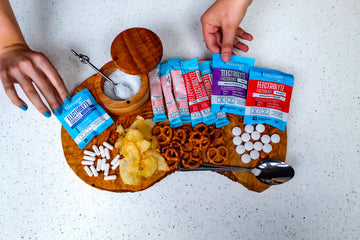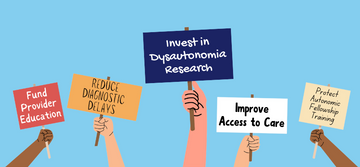
"Drink more water and eat a lot of salt!” has long been the first and go-to advice given to people who are diagnosed with Postural Orthostatic Tachycardia Syndrome (POTS). We recently asked our Vitassium Instagram followers what they wanted to know about salt and POTS, and here are some of the FAQs:
How does increased sodium intake help manage POTS symptoms?
The body’s sodium content helps to determine the extracellular fluid in the body, including plasma, which is an important factor in determining blood volume. An increase in blood volume increases orthostatic tolerance and may help reduce your POTS symptoms. Research indicates that increased sodium intake may also decrease baroreceptor response and the levels of standing norepinephrine in the body, and both decreases can minimize POTS symptoms.

What is the difference between salt and sodium?
Although the words “salt” and “sodium” are often used interchangeably, they do not mean the same thing. We most commonly associate the term “salt” with “table salt” or “sodium chloride”. Meanwhile, sodium is what you normally see on the back of food nutritional labels.
However, they are not the same! For example, 1 gram of salt (1,000 milligrams) contains 400 mg of sodium. If your provider suggests taking 1 g of salt, confirm whether they mean salt or sodium. Then you can consume either 1 g of table salt, or 400 mg of sodium as indicated on food labels.

How much sodium should I take?
It is recommended that POTS patients should have a minimum intake of 2 to 3L of water per day along with increased sodium intake. Sodium intake can be increased to 3g to 10g daily using ordinary table salt (1 tsp. is approximately 2.3g sodium), salt capsules such as Vitassium, or electrolyte solutions. The exact amount of sodium and hydration increase can change from patient to patient and can vary between symptom severity. Consult with your healthcare provider to explore the right level for you.
Some Vitassium consumers take as few as two capsules per day, which translates to 500mg of extra sodium. Others take more than eight per day, which equates to more than 2,000mg of extra sodium. Keep in mind, these patients are also getting extra salt through their diet, which is usually high in salty foods such as salted potatoes, eggs or drinks such as V-8.
Do I only need sodium or do I also need other electrolytes?
The body manages its electrolyte levels through a balance of ratios, and one important ratio is between sodium and potassium. Increasing sodium and water intake may help manage your symptoms, but sufficient potassium intake is also necessary. The body always wants to maintain a balance of sodium and potassium; therefore, if potassium levels are too low, sodium absorption through the digestive system may be inhibited. In which case, consuming additional sodium without potassium would be useless.
How can I increase sodium consumption with a sensitive stomach?
Not all salt is created equal. If you’ve been told to increase your sodium, you may have noticed that high amounts of salt (i.e. “sodium chloride”), especially in a tablet or capsule form, may hurt your stomach or cause bloating, cramping, and nausea. This is because excess salt can affect the extracellular fluid in your stomach and intestinal lining, pH levels, and “good bacteria” levels.
In contrast, Vitassium capsules are specifically made for people with POTS and sensitive stomachs. Vitassium capsules are buffered, non-GMO, vegan, gluten free, preservative free, allergen free, soy free, and starch free. And if you’re curious what “buffered” means, essentially, it’s designed to be gentler on the stomach by minimizing the impact on pH balance.
Many people with POTS also have gastroparesis and may need a feeding tube to obtain their nutritional needs. Tips for increasing salt intake if you have a feeding tube include eating drainable snacks and sucking on FastChews, which can provide rapid symptom relief without having to digest them because they're absorbed through the lining of the mouth.
Are there any long-term effects of following a high sodium diet for POTS?
Research is limited and does not give any insight into the long-term effects of a high salt diet. However, it is well documented that people with cardiovascular and kidney diseases should not be on a high sodium diet, and that high sodium diets may cause issues with high blood pressure, the cardiovascular system, kidneys, and stomach. It’s best to speak to your healthcare provider about the risks and benefits of a high sodium diet for you, individually.
Should people with hyperadrenergic POTS follow a high sodium diet?
In people with hyperadrenergic POTS, the sympathetic nervous system is overactivated. People with this subtype of POTS have elevated blood pressure and blood levels of norepinephrine when upright. A recent small study indicated that, compared with those on a low-sodium diet, people with POTS on a high-sodium diet can demonstrate a smaller increase in heart rate and lower norepinephrine level, and aldosterone level while upright. This suggests that a high sodium diet may lower heart rate and norepinephrine levels in people with hyper-POTS. However, the research is limited. We recommend talking to your healthcare provider about what is best for you.







